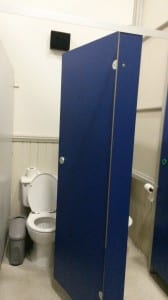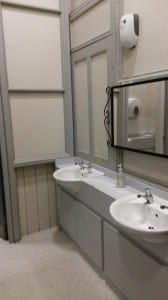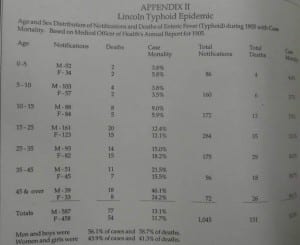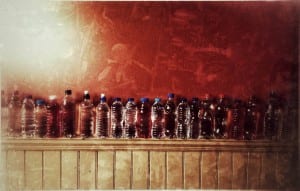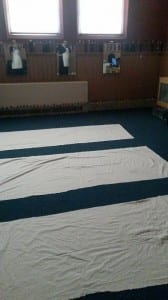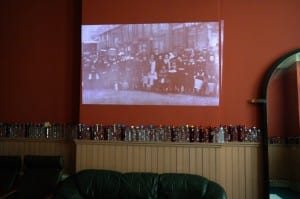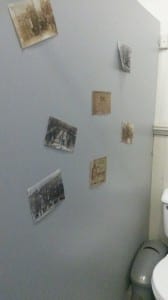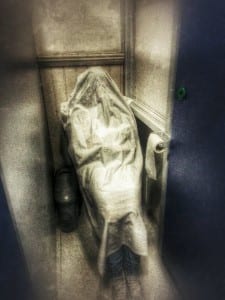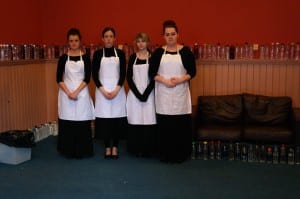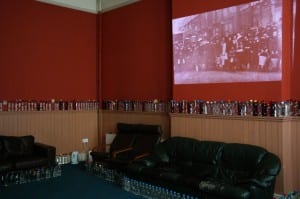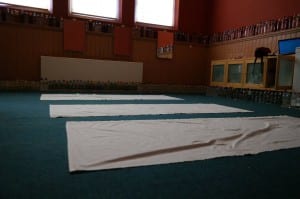Framing Statement
“Theatre is theatre but what do you get when you work outside of a theatre space” (Dorner, 2005)
The Final Countdown focuses on the typhoid epidemic in Lincoln between 1904-1905 that got spread from drinking infected water. The Drill Hall’s auditorium had to be used as an emergency hospital since hospitals were filled with too many patients. This site specific performance immerses the audience into patients and the patients will have to re-live and feel what it was like to live back in the days when drinking water was a threat within the Lincoln community.
The Final Countdown is a performance devised and based around water. Physical contact and trust were two big elements we needed our audience to collaborate with; therefore we relied deeply on our audience’s participation. We needed them to participate actively in our performance and do as they were instructed to in order for the performance to have a powerful effect on them. “A site is just a physical given- it’s where you locate your body in relation to how you manipulate it, and how it manipulates you as a physical thing” (Kaye, 2008).
The audience is a vital part of the performance; they are indeed re-living the experience of being patients back in 1905 when the auditorium was used as a hospital, and us actors are nurses taking care of them. In order for our audience to have a full outcome of the experience, we decided to make it sensory and visual; we used the sense of smell, where they would smell disinfectant as soon as they would walk into the room which would make them think of being in a hospital. We also had a kettle that would boil the water, which they would hear, they would also hear the flushing of toilets, dripping water and personal stories from the 1904-1905.
Our performance is based around water and how it got infected which would give people typhoid as stated earlier. In order to stay away from the disease, boiling water before drinking it was a need in order to kill the germs, however not everyone knew this back then and didn’t have the means for it. The Final Countdown is a 15 minute performance, which is designed for 3 participants at a time. We wanted our audience to learn and remember about the typhoid outbreak in a different way “Within contemporary performance, site-related work has become and established practice where an artist’s intervention offers spectators new perspectives upon a particular site or set of sites” (Govan and Nicholson and Normington, 2007). We wanted to educate them in a different and original way.
An Analysis of Process
I have always been interested in history and having heard of the Drill Hall’s history was particularly fascinating for me; I loved learning ad hearing about all the different events the Drill Hall had been through. The typhoid outbreak that occurred in December 1904 particularly drew my attention to the subject and along with 3 other people we decided to research more upon that subject, since we were all interested in it. We eventually found out that the auditorium had been used as an emergency place for people who had been affected by the typhoid; there wasn’t enough room in the hospitals and the auditorium in the Drill Hall had to be used. “It had to be used as an extra hospital because the hospitals did not have enough room and beds, therefore the auditorium in the Drill Hall had to be borrowed”(Kirkwood, 2015).
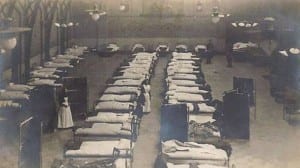
Figure 1
As you can see from the picture above that was taken in 1905 in the Drill Hall auditorium, this is how the conditions were for the sick patients; indeed, it was very crowded and there was a lack of space and privacy. We thought how terrible the conditions were for the people who were ill and had to experience the lack of privacy, small space and lack of nurses. Since we were all very interested in the history of the typhoid outbreak and that the Drill Hall had to be used as a hospital, we knew we wanted to base our performance around this subject. However, we were stuck on where to have our performance performed since we couldn’t have the auditorium all to ourselves, because other groups would want to use it as well. If we would have used the auditorium with the other groups, it would lose its intimacy and the experience for our audience wouldn’t be the same and our point wouldn’t come across.
“A large part of the work has to do with researching a place, often an unusual one that is imbued with history or permeated with atmosphere” (Pearson, 2010). We had a look around all of the other rooms in the Drill Hall, but had no luck; we had no idea how we would find a room that would link with the history of the typhoid outbreak. It finally came to us when we all went to the bathroom. We were all so frustrated that we couldn’t find a room so we started messing around and played with the tap water. That is when the idea of having our performance based around water came to us “To see the space you also have to feel the space” (Dorner, 2005). We were able to find the link between the typhoid; it was the water that would poison the people and make them sick since the water was dirty.
According to our research from the archives, all drinking water had to be boiled in order to kill the germs to avoid getting typhoid. “Even though there had been no notifications it was not until 21st January, 1905 that the Corporation’s first public warnings about boiling drinking water were appearing in the middle of other public announcements” (Lincolnshire Archives, 2015). After having visited and played around in the bathroom in order to get inspired, we decided to have part of our performance based in the bathroom cubicles.
Figure 2 Figure 3
As you can see on the pictures above, Figure 2 is one of the cubicles; it is a very small and intimate place. There isn’t a lot of space, it would be crowed if someone would be in there and it can appear quite claustrophobic. Figure 3 shows how big the space is.
This is what we wanted to achieve, we wanted our audience to feel what it was like for the patients back then and we wanted to take them on a journey and make them experience what the patients had to experience back in between 1904-1905. Since our piece would be based of water, we thought that whilst we would have each of our patients in the cubicles we would have the tap water running as you can see on Figure 3.
We wanted our performance to remain intimate; when watching or taking part in a performance with other people in it, it can influence your experience of the performance. You might act differently when you are around other people, you might not be as brave to experience things or you might hold back in order to not look foolish in front of your friends. Taking part of the experience by yourself makes you focus more on the actors and the message they are trying to get across. It also becomes more intimidating for you to take part of an experience by yourself. This is why we wanted to have one audience member in each cubicle, we wanted them to re-live the experience when the patients had to be in the Drill Hall and there was a lack of space; the cubicles are very small and space is limited.
We also wanted our audience to be daring and experimental. Just like Marina Abramovic who is very experimental during her performances, we took inspiration from her performance Imponderabilia regarding the space of the performance. “What you experience will always stay with you, that is why I like to create a platform for interactions so people can experience something for themselves” (Abramovic, 2015). Her performance consists of 2 naked actors from different genders standing in front of a museum entrance; the audience therefore need to chose if they are willing to go through them and which way they would face. They are unaware that the performance has already started. This space is important to this particular performance, if they were not standing at the entrance of the museum the piece would have been unsuccessful. For instance, if the actors were stood in the middle of the space although the spectators may still feel slightly uncomfortable they would not feel pressure to decide in front of other people which way they had to face to enter the place. Therefore, they would not have been involved in the performance and the social experiment. Our performance consists of our audience taking decisions for themselves and dare themselves to take part of our performance ; even though ours isn’t a social experiment like Abramovic’s, we still ask a lot from our audience.
As we continued our research about the typhoid symptoms, we discovered that they were divided in a period of 4 weeks before you would pass away from it. We decided to pick the bathroom that had 3 cubicles in it so we could separate our audience into each week of symptoms and have it read out to them. The last week would be read out loud to everyone and they would all experience the last week, which is the week they die. The experience would still remain personal since they were separated from their friends and would experience something different from each other. Curious’ On the Scent helped us develop our piece; this performance is based on a sensory experience where you use your smell, taste, touch and hearing to experience the performance. “When you act-when you do something-you make a memory in your body-and in your mind-you experience space” (Dorner, 2005). Indeed, On the Scent helped us develop our piece. “On the Scent explores the elusive connections between smell and memory” (Curious, 2015).
In order for our audience to have a better and richer outcome of this performance, recreating the experience for them wasn’t enough for us; we wanted to play around with smells and things they would hear, which would trigger their experience and help them through the journey. Since 3 audience members would be present in the cubicles however experience different things, we would have one nurse in front of each cubicle. In the right order, she would read out the symptoms to the audience, for example the audience member who was in the first cubicle would experience the symptoms in week 1. The nurse would put a cold compress on the audience’s member’s head when she said “Your body temperature is starting to rise slowly” (Lincolnshire Archives, 2015), this way their experience would become visual and physical, it would become easier for our audience to imagine what they had to go through as we put them in the patients position. This is the reaction we were looking for.
We also decided to have our piece performed with the audience having their eyes closed for most of it. On the Scent helped us develop this idea; having their eyes closed would help them focus on all of their other senses. They would also create visual images in their heads whenever we would speak, whenever they would hear running water and whenever we could make physical contact with them like putting a flannel on their heads.
After having been to the archives, we had found loads of information regarding the typhoid epidemic and we had found loads of personal stories. We wanted to include these in our performance so our audience would connect with the people back in Lincoln in 1904 as this affected men, women and children from all classes. However, we decided to have this performed in a different room; we also wanted to demonstrate the number of people who got affected by the disease by having an installation, so that the audience would realise it. We would have our audience switch rooms with their eyes closed, as w wanted them to stay in that mind set and not break out of character. It’s easy to say to someone that the disease affected 1045 people, but once you actually see the number in front of you it’s easier to imagine and the information affects you more. We took this from Stan’s café All of the People in all the World where one grain of rice would represent one person “We wanted to understand how many people there were in the world-we knew the number-but we didn’t know what it meant. We thought if we could look at 6,2000,000,000 objects gathered together then that might help us understand” (Stan’s café, 2015). Since our performance was based on water and we wanted to empathise this, we decided to have our installation of people represented by water bottles. “Performance can function as a means of exposition and representation, animating: precipitating, visitation and participation” (Pearson, 201O). According to our research from the archives, 1045 people were affected by the disease and 131 died from the typhoid.
Figure 4
We knew what our next mission was…collect 1045 empty water bottles in order for it to look realistic and we borrowed this from All of the People in all the World. Once we had collected all of the bottles, we had to fill 131 of them with red food dye in order to represent the number of people who died. The red would represent the disease having killed people, and it linked nicely with the image of blood. The room would therefore be filled of water bottles, however our next problem was where would we have this performed?
We found a room next to the bathroom called the green room. It was a big space where we thought we would be able to display all of the water bottles in there; we would have the room covered with bottles so it would be a little bit of a shock to the audience when they would walk in. The room had curtains and windows that reminded us all of church since it had the same design, we thought it would be symbolic to have it performed in this room since it would link nicely with people being dead and the church atmosphere, we would be paying respect to the patients.
Figure 5 Figure 6
As you can see on Figure 5, this is the effect the lighting created on the water bottles with curtains drawn; it created a very peaceful, relaxing environment. As the audience would walk in, we would have them lie down on 3 hospital sheets as you can see on Figure 6. They would represent the beds in the hospital and were close to each other, showing the lack of privacy and personal space.
With having On the Scent in our minds, we wanted to evoke our audience’s sensory experience even more. Looking back on our archives research, we had found out that disinfectant played a big role in the hospitals; it would eliminate the germs and hospitals were filled of that smell. In order to bring that smell and memory to our audience, one of the nurses would stand outside the green room inspecting everyone’s hands and giving them disinfectant to rub on their hands. The audience would therefore have the smell of disinfectant and it would help them get the image of being in a hospital in their heads. As soon as they walked in, the 1045 bottles filled with water, and 131 with red dye would surround them. A projection of children was projected onto the wall so it would be the first thing the audience would see; we made it into a video style, the image was in black and white and trembling, as if it was filmed back then, as you can see on Figure 7.
Figure 7
A Performance Evaluation
During our final performance, our audience members seemed to enjoy our piece and felt safe between the nurses’ hands. Whilst I had to lead them with their eyes closed from the green room to the bathroom, I asked them to remain with their eyes closed; I held their arms and walked backwards whilst they were facing the right way to walk into the bathroom. This way, they would feel safer to feel someone was in front of them guiding them; I also kept talking to them and reassuring them everything was fine, just like a nurse would do. We thought this procedure was a success since none of the audience members opened their eyes whilst I guided them with their eyes closed. Physical contact was therefore a success, the audience felt safe in my hands and none of them refused to be guided with closed eyes.
Their involvement and reaction seemed positive; they would drink the water when told to do so, without complaining or asking what was in it and being picky; of course we had prepared ourselves in case they would hesitate to drink it by reassuring them and talking them into it.
One way we could have improved our performance was to eliminate the soft music we had during the time we would tell the personal stories and the poem. The fact we chose to have soft music was because we wanted to take away some of the sounds coming from outside, we didn’t want the traffic sound to affect our performance. However, having the soft music took away the focus on us actors, and our installation since the audience would focus on the music.
If I could have altered the performance, I would have a few more actors in the room pretending they were patients, just like the audience. I would have it like this in order to create the space more claustrophobic and intimidating for the audience, it would clearly be a lack of personal space to the extent. I also think we could have made this performance more experimental and push the boundaries of theatre; we could have played a bit more around their senses. However, I do think it was a successful piece making them re-live the experience of being patients with a small claustrophobic space and was relevant to the site. Site-specific theatre can be performed anywhere; “I can take any empty space and call it a bare stage” (Brook, 1972). My knowledge to site specific theatre was very poor before taking this module and I couldn’t understand how theatre could be performed in another way than on a stage; it has therefore made me a more open minded person about theatre “The site is a place where a piece should be but isn’t” (Smithson, 1996).
Performance Pictures
Inside one of the cubicles
One of the patients
Nurses’ costumes
The green room
The green room
Word Count: 3121
Bibliography
Abramovic, M. (2015) Ekebergparken. [online] Available from http://www.ekebergparken.com [Accessed 14 May 2015].
Brook, P. (1972) The Empty Space. New York: Touchestone.
Curious (2015) On the Scent. Available from http://www.placelessness.com/project/1121/on-the-scent/ [Accessed 14 May 2015].
Govan, E. and Nicholson, H. and Normington, K. (2007) Making a Performance. London: Routledge.
Kaye, N. (2008) Site Specific Art: Performance, Place and Documentation. London: Routledge.
Kirkwood, C. (2015) Drill Hall History and Marketing. interview [Interviewed by Maria Yngvell] 11 March 2015.
Pearson, M. (2010) Site Specific Performance. London: Palgrave Macmillan.
Seminar 2, Powerpoint Dorner, 2005.
Smithson, R. (1996) Bear and Sharp. London: Routledge.
Stan’s café (2015) All of the people in all the world. Available from http://www.stanscafe.co.uk/project-of-all-the-people.html [Accessed 14 May 2015].
Visit to Lincolnshire Archives 13th February 2015.

